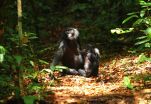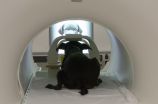(Press-News.org) (BOSTON) - Super productive factories of the future could employ fleets of genetically engineered bacterial cells, such as common E. coli, to produce valuable chemical commodities in an environmentally friendly way. By leveraging their natural metabolic processes, bacteria could be re-programmed to convert readily available sources of natural energy into pharmaceuticals, plastics and fuel products.
"The basic idea is that we want to accelerate evolution to make awesome amounts of valuable chemicals," said Wyss Core Faculty member George Church, Ph.D., who is a pioneer in the converging fields of synthetic biology, metabolic engineering, and genetics. Church is the Robert Winthrop Professor of Genetics at Harvard Medical School and Professor of Health Sciences and Technology at Harvard and MIT.
Critical to this process of metabolically engineering microbes is the use of biosensors. Made of a biological component - such as a fluorescent protein - and a 'detector' that responds to the presence of a specific chemical, biosensors act as the switches and levers that turn programmed functions on and off inside the engineered cells. They also can be used to detect which microbial 'workers' are producing the most voluminous amounts of a desired chemical. In this way, they can be thought of as the medium for two-way communication between humans and cells.
But so far, scientists have only had access to a limited variety of biosensors that have little relevance to the bio-manufacturing of valuable chemicals. Now, Wyss Institute researchers led by Church have developed a new suite of such sensors, reported in Nucleic Acids Research journal, that not only increase the number of cellular "switches and levers" that scientists can use for complex genetic re-programming, but also respond to valuable products such as renewable plastics or costly pharmaceuticals and give microbes a voice to report on their own efficiency in making these products.
"We can communicate with cells much more effectively, and vice versa," said the study's first author Jameson Rogers, a graduate researcher at the Wyss Institute who is pursuing his Ph.D. in Engineering Sciences from Harvard University. "If we compared this to controlling a computer, it's almost like we have only had the up and down arrows available to us, and now suddenly we have doubled our control capabilities by adding the left and right arrows as well."
The Wyss team aims to leverage the new biosensors to aid in their efforts to develop renewable chemical production strategies using genetically engineered microbes.
Linked to green fluorescent protein (GFP), the biosensors can be used to trigger individual cells to give off visible fluorescence in a rate directly proportional to how well they are able to produce a desired chemical commodity. Using the new biosensors, the most efficient microbial workers are easily identified so that they can serve as the predecessors for colonies of engineered bacteria that evolve to become more efficient at producing renewable chemicals with each subsequent generation. This drastically reduces the bottleneck of the design-build-test cycle, which has historically been caused by engineers having to sift through teeming bacteria colonies to find top producers.
The findings could also lead to new applications in environmental monitoring using genetically engineered microbes to issue warning signals in the presence of pollutants or toxins, and could unlock new fundamental insights into metabolic pathways.
"Our team is developing several different ways to make even more custom biosensors," said Church. "We're trying to control biological processes and we need new ways to get our hands in at the molecular level - we're now reaching in deeper than we've previously been able to, and we still have many interesting new approaches."
"With this work, George and his team are bringing us closer to a sustainable future in which we would rely on bio-manufacturing for the clean production of chemical and pharmaceutical commodities," said Wyss Institute Founding Director Donald E. Ingber, M.D., Ph.D., who is also the Judah Folkman Professor of Vascular Biology at Harvard Medical School and Boston Children's Hospital, and Professor of Bioengineering at the Harvard John A. Paulson School of Engineering and Applied Sciences.
INFORMATION:
The Wyss Institute for Biologically Inspired Engineering at Harvard University uses Nature's design principles to develop bioinspired materials and devices that will transform medicine and create a more sustainable world. Wyss researchers are developing innovative new engineering solutions for healthcare, energy, architecture, robotics, and manufacturing that are translated into commercial products and therapies through collaborations with clinical investigators, corporate alliances, and formation of new start-ups. The Wyss Institute creates transformative technological breakthroughs by engaging in high risk research, and crosses disciplinary and institutional barriers, working as an alliance that includes Harvard's Schools of Medicine, Engineering, Arts & Sciences and Design, and in partnership with Beth Israel Deaconess Medical Center, Brigham and Women's Hospital, Boston Children's Hospital, Dana-Farber Cancer Institute, Massachusetts General Hospital, the University of Massachusetts Medical School, Spaulding Rehabilitation Hospital, Boston University, Tufts University, and Charité - Universitätsmedizin Berlin, University of Zurich and Massachusetts Institute of Technology.
Some neutron stars may rival black holes in their ability to accelerate powerful jets of material to nearly the speed of light, astronomers using the Karl G. Jansky Very Large Array (VLA) have discovered.
"It's surprising, and it tells us that something we hadn't previously suspected must be going on in some systems that include a neutron star and a more-normal companion star," said Adam Deller, of ASTRON, the Netherlands Institute for Radio Astronomy.
Black holes and neutron stars are respectively the densest and second most dense forms of matter known in the Universe. ...
From an early age, human infants are able to produce vocalisations in a wide range of emotional states and situations - an ability felt to be one of the factors required for the development of language. Researchers have found that wild bonobos (our closest living relatives) are able to vocalize in a similar manner. Their findings challenge how we think about the evolution of communication and potentially move the dividing line between humans and other apes.
Animal vocalisations are usually made in relatively narrow behavioural contexts linked to emotional states, such ...
Washington, DC-- Climate change caused by greenhouse gas emissions will alter the way that Americans heat and cool their homes. By the end of this century, the number of days each year that heating and air conditioning are used will decrease in the Northern states, as winters get warmer, and increase in Southern states, as summers get hotter, according to a new study from a high school student, Yana Petri, working with Carnegie's Ken Caldeira. It is published by Scientific Reports.
"Changes in outdoor temperatures have a substantial impact on energy use inside," Caldeira ...
A team of scientists believe they have shown that memories are more robust than we thought and have identified the process in the brain, which could help rescue lost memories or bury bad memories, and pave the way for new drugs and treatment for people with memory problems.
Published in the journal Nature Communications a team of scientists from Cardiff University found that reminders could reverse the amnesia caused by methods previously thought to produce total memory loss in rats. .
"Previous research in this area found that when you recall a memory it is sensitive ...
Dogs have a specialized region in their brains for processing faces, a new study finds. PeerJ is publishing the research, which provides the first evidence for a face-selective region in the temporal cortex of dogs.
"Our findings show that dogs have an innate way to process faces in their brains, a quality that has previously only been well-documented in humans and other primates," says Gregory Berns, a neuroscientist at Emory University and the senior author of the study.
Having neural machinery dedicated to face processing suggests that this ability is hard-wired ...
Trauma may cause distinct and long-lasting effects even in people who do not develop PTSD (post-traumatic stress disorder), according to research by scientists working at the University of Oxford's Department of Psychiatry. It is already known that stress affects brain function and may lead to PTSD, but until now the underlying brain networks have proven elusive.
Led by Prof Morten Kringelbach, the Oxford team's systematic meta-analysis of all brain research on PTSD is published in the journal Neuroscience and Biobehavioural Reviews. The research is part of a larger ...
CHARLOTTESVILLE, VA (AUGUST 4, 2015). Researchers at the University of Virginia (UVa) examined the number and severity of subconcussive head impacts sustained by college football players over an entire season during practices and games. The researchers found that the number of head impacts varied depending on the intensity of the activity. Findings in this case are reported and discussed in "Practice type effects on head impact in collegiate football," by Bryson B. Reynolds and colleagues, published today online, ahead of print, in the Journal of Neurosurgery.
The researchers ...
August 4, 2015 -- Treating maternal psychiatric disorder with commonly used antidepressants is associated with a lower risk of certain pregnancy complications including preterm birth and delivery by Caesarean section, according to researchers at Columbia University's Mailman School of Public Health, Columbia University Medical Center, and the New York State Psychiatric Institute. However, the medications -- selective serotonin reuptake inhibitors, or SSRIs -- resulted in an increased risk of neonatal problems. Findings are published online in the American Journal of Psychiatry.
"To ...
Chestnut Hill, MA (August 4, 2015): It's been said that "Those who don't know history are doomed to repeat it," but even if you know your own history, that doesn't necessarily help you with self-control. New research published in the Journal of Consumer Psychology shows the effectiveness of memory in improving our everyday self-control decisions depends on what we recall and how easily it comes to mind.
"Despite the common belief that remembering our mistakes will help us make better decisions in the present," says the study's lead author, Hristina Nikolova, Ph.D., an ...
PHILADELPHIA - The roughly nine million Americans who rely on prescription sleeping pills to treat chronic insomnia may be able to get relief from as little as half of the drugs, and may even be helped by taking placebos in the treatment plan, according to new research published today in the journal Sleep Medicine by researchers from the Perelman School of Medicine at the University of Pennsylvania. Their findings starkly contrast with the standard prescribing practices for chronic insomnia treatment.
The findings, which advocate for a dosing strategy of smaller and fewer ...

